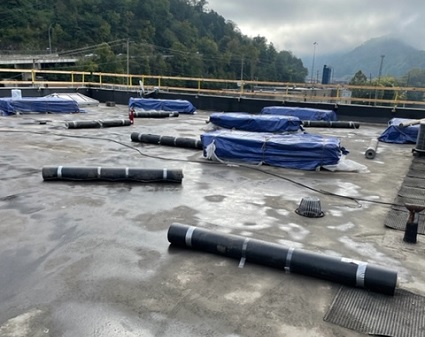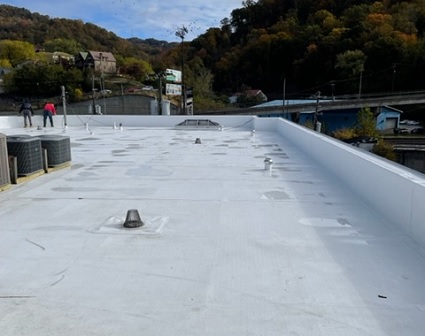Project
Truist Bank Roof ReplacementLocation
Williamson, WVContractor
Radco Roofing & ConstructionSystem
Reclaimed Existing Polyiso Insulation
3/8″ DexCell Cement Board
60 mil Triton Protan SE PVCProject Size
8,417 square feetCompletion
October 2022





It is difficult to avoid a full tear-off and replacement with existing ballasted EPDM roofs because the existing membrane and insulation are loose-laid, only being held down by the stone ballast. Traditionally, when these roofs are past their useful life, they are completely torn off and replaced, as restoration and recover options are usually not feasible. On this Truist bank branch, Triton provided a hybrid alternative which allowed the bank to avoid the waste and cost of replacing good, dry insulation, but receive a new slip-resistant thermoplastic membrane without adding fasteners or using ballast.
After a thorough roof analysis confirmed that the majority of the existing polyiso insulation was dry, Triton assisted in designing a non-traditional roof system that would not only save costs and reduce waste, but result in a stronger, safer membrane with unlimited wind uplift resistance. Considering this was a structural concrete deck, mechanical attachment needed to be avoided at all costs. Due to constant issues, there was no prudent reason to re-use the stone ballast. This eliminates any option to restore or recover the existing loose-laid EPDM with a liquid membrane or a conventional single-ply recover. The concrete deck was inspected and confirmed to be airtight and load-bearing. This meant a wind-vented, vacuum system using Venturi principles was a viable design option, instead of the conventional, expensive approach of tear-off with new fully-adhered insulation and single-ply.
The project was executed quickly and without hiccups by the certified roofing contractor. They removed and disposed of the existing stone ballast and EPDM membrane. The existing insulation was pulled up in sections and a new air/vapor barrier was fully adhered in adhesive over the concrete deck as a safeguard to ensure the deck remains airtight. The dry insulation was placed back into place and a new, durable cement cover board was added over the insulation. The small amount of wet insulation was replaced with new iso. The new 60 mil Triton Protan PVC single-ply membrane was loose-laid over the new cover board. Following design guidelines, proprietary equalizer vents were installed in all corners and along the perimeter. These vents allow air pressure to escape the system in order for vacuum principles to take hold. The faster the wind blows across the surface, the harder the PVC membrane is sucked down towards the deck, holding everything tightly in place.
Not only was this system chosen due to the cost and waste avoidance, but for the properties of the Triton PVC membrane itself. The new PVC membrane is much stronger and durable than EPDM or TPO. Unique to Triton, all Protan PVC has a slip-resistant, patterned surface to reduce the chance of slips and falls when the surface is wet from dew, rain, or snow. It is common in West Virginia for a white roof to be wet. Regular smooth TPO and PVC are very slippery when wet and lead to injuries when people are on the roof working with HVAC, electrical, plumbing, etc. Truist was very happy to reduce liability related to potential occupational injuries, when compared to traditional options. Additionally, Triton provided a 20-Year NDL material and labor warranty upon completion of the project.

